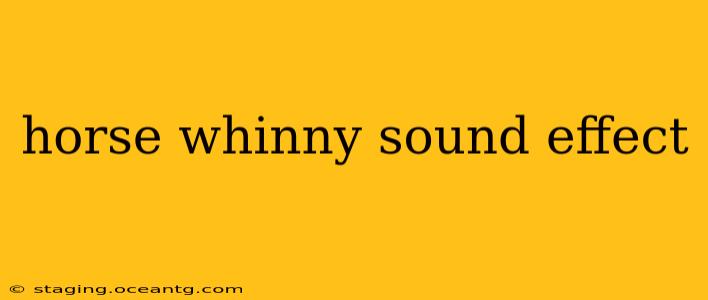The distinctive whinny of a horse is a sound instantly recognizable worldwide. This seemingly simple vocalization, however, holds a wealth of information about the horse's emotional state, social standing, and even its individual personality. Understanding the nuances of a horse whinny sound effect—from its creation to its implications—is key to appreciating the complex communication system of these magnificent animals. This article will delve into the intricacies of equine vocalizations, exploring their various forms and the underlying reasons behind them.
What is a Horse Whinny?
A horse whinny is a high-pitched, drawn-out neigh typically used for long-distance communication. Unlike a snort or a nicker, which serve different purposes, the whinny is primarily used to contact other horses, often those located some distance away. Think of it as a horse's way of saying "hello" or "where are you?". The sound itself can vary depending on the horse's breed, age, and emotional state. A young foal's whinny will sound noticeably different from that of a mature stallion.
What Causes a Horse to Whinny?
Several factors trigger a horse's whinny. Understanding these can provide valuable insights into their behavior:
Contacting Other Horses: This is the most common reason. Horses use whinnies to locate their herd members, particularly if separated. A lost foal might whinny frequently, calling out for its mother. Similarly, horses in adjacent paddocks might whinny to each other.
Expressing Excitement or Distress: A high-pitched, rapid whinny can indicate excitement, perhaps in response to anticipation of food or interaction with a familiar human. Conversely, a low-pitched, drawn-out whinny might signal distress or anxiety. The context is key in understanding the emotional underpinnings.
Responding to Familiar Sounds or Smells: Horses have incredibly sensitive hearing and smell. A familiar sound, such as the sound of a vehicle approaching that regularly brings food, might trigger a whinny. Similarly, the smell of a beloved human might elicit a friendly whinny.
Seeking Attention: A horse may whinny to attract attention, whether it's for food, water, or simply some human interaction.
How is a Horse Whinny Sound Effect Created?
The whinny sound is produced in the horse's larynx, or voice box, through the vibration of its vocal cords. The precise pitch and intensity of the whinny are controlled by the tension and position of the vocal cords, as well as the airflow from the lungs. The unique shape of a horse’s vocal tract further contributes to the characteristic sound of the whinny.
What are Different Types of Horse Sounds?
Horses don't just whinny. They communicate through a complex range of vocalizations:
- Neigh: A prolonged, high-pitched sound, typically used for long-distance communication.
- Whinny: Similar to a neigh but often shorter and less intense.
- Nicker: A soft, low-pitched sound used for close-range communication, often between a mother and foal.
- Snort: A short, forceful expulsion of air through the nostrils, often expressing alarm or annoyance.
- Roar: A deep, guttural sound produced primarily by stallions, usually a display of dominance.
Where Can I Find Horse Whinny Sound Effects?
Numerous online resources offer horse whinny sound effects, ranging from simple recordings to more complex, edited versions. These sound effects are commonly used in various media, from film and television to video games and educational resources.
Conclusion
The horse whinny sound effect is more than just a noise; it’s a window into the intricate communication system of these remarkable animals. By understanding the nuances of these vocalizations, we can gain a deeper appreciation for their social dynamics, emotional range, and remarkable capacity for expression. Further study into equine communication promises to unveil more about their intelligence and social structures.
